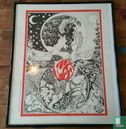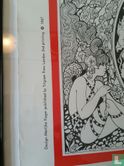


Enlarge image
Love Life



Catalogue information
LastDodo number
5533593
Area
Poster
Title
Love Life
Type
Main subject
Sub-series
Event location
Designer
Publisher
Year
1967
Number produced
Numbering off
Numbering to
Signature
Language
Country
Theme
Printing technique
Colouring
Dimensions
45.0 x 58.0 cm
Details
'Love Life', a lithograph poster printed in black and red.
Designed by Marijke Koger and published by the Trigram Press, London, 1967.
In the collection of the Victoria and Albert Museum, the world's greatest museum of art and design.
Source: http://collections.vam.ac.uk/item/O1023212/love-life-poster-koger-marijke/
About the designer
'Marijke Koger (1943) was the primary visual artist behind the four-person art group ‘The Fool’, a Dutch design collective (and later band) who rose to prominence in late 1960’s London. Alongside Koger ‘The Fool’ consisted of fellow artist Simon Posthuma, Fashion Designer Yosha Leeger and Barry Finch, the groups name being derived as a reference to the Tarot Card. The Fool made a tremendous impact at the time via there work for the Beatles, Cream and The Move to name but a few. In fact such was the popularity of the group that despite having few musical inclinations they record a Psych-Folk album produced by Graham Nash – I’ve got to track that one down!
Read more about ‘The Fool‘ collective or visit Marike’s official site www.maryke.com.'
Source:
http://www.sci-fi-o-rama.com/2013/04/07/electrical-banana-masters-of-psychedelic-art/
What others say about Koger and Love Life
'A slight return to The Fool, and specifically the work of Marijke Koger. Since The Fool was a collective it can be difficult separating out the work of individuals but all of these examples are credited as hers in Norman Hathaway & Dan Nadel’s excellent Electrical Banana (2011) book. The nature of the collective also tends to downplay the contribution of women to psychedelic art, with Koger tending to receive less individual credit than Bonnie MacLean does for her US concert posters.
Koger’s Love Life design is very advanced for 1966, and could easily have been created at almost any time in the next decade.'
Source: http://www.johncoulthart.com/feuilleton/2013/07/16/the-art-of-marijke-koger/
'Koger did not engage with modernism or pop art, preferring a more accessible, almost colloquial approach to art-making. This is not psychedelic art made by a designer or psychedelic designs made by an illustrator, but rather full-blown psychedelic visuals made by a woman who inhabited that space in her mind’
Source:
Electrical Banana (Feb 2012)
by Dan Nadel & Norman Hathaway





